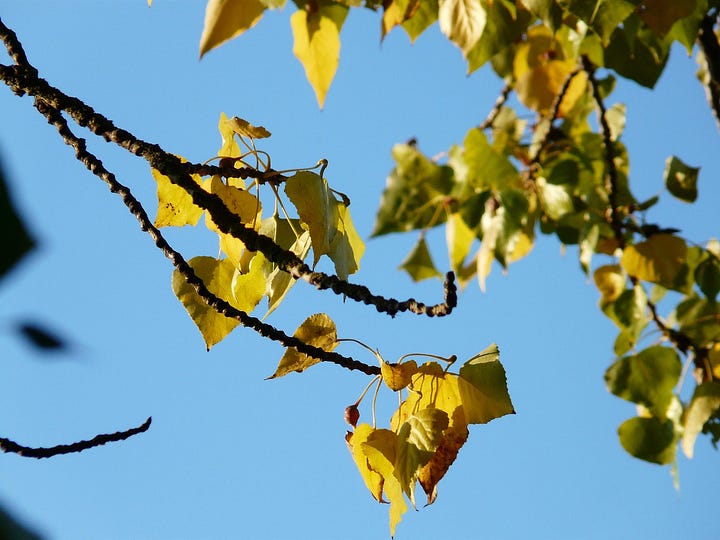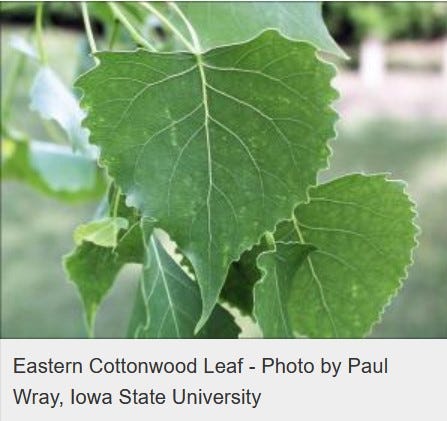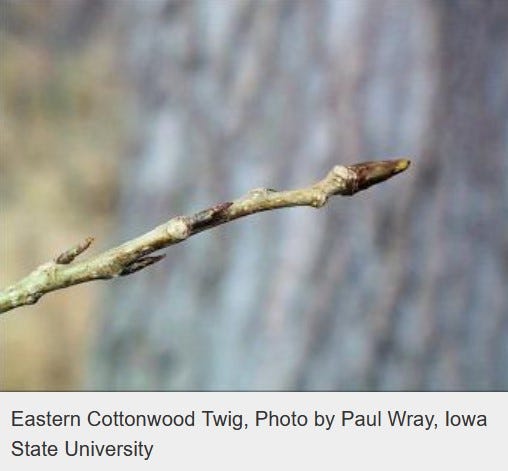There IS a balm in Gilead, although at one time, "the weeping prophet" Jeremiah dispaired of this. The season for foraging the active ingredient of today's version of the balm is upon us, as we're approaching the halfway point of winter, because you need to get those cottonwood buds before they open up. First, take a a short side trip through the history of the name, then discover which tree you should be searching near the water ways and wetter areas of your own region.
Gilead was an actual location in the ancient world, east of the Jordan river, occupied by 3 of the tribes of Israel, but even prior to that, it was known as a place where spices, medicinal herbs, and a particular, wound healing balm were available and traded.
We can't say for certain what was in that ancient Middle Eastern balm, but something called Commiphora opobalsimum a.k.a. Commiphora gileadensis of the family Bursaraceae, is historically associated with it. That aromatic plant is related to C. myrrha, from which myrrh is obtained, and C. mukul, also known from Ayurvedic medicine as guggul. In ancient times, Commiphora opobalsimum was highly valued for the scent, use in cosmetics and medicine, and was a rare commodity generally reserved for royalty.
Over the millennia the Biblical Balm of Gilead became a metaphor for healing in general, particularly spiritual healing.
This balm came to my attention years ago, in a song, (since I have played stringed instruments for a long time). 'Balm in Gilead' was a classic spiritual picked up from Black Americans (perhaps from mid 19th century?), and put into a 1907 collection of such songs by John Work. (This was back in the days when cultural appropriation was a viable way of preserving the practices of any given population, spreading them, and helping to prevent them from dying out.) The concepts in the song relate to the 3 mentions of the Balm of Gilead in the Old Testament of the Bible as a both a physical thing and a metaphor, and it linked the spiritual healing to the mission of Jesus Christ.
'There Is a Balm in Gilead' lyrics:
Refrain: There is a balm in Gilead to make the wounded whole, there is a balm in Gilead to heal the sin-sick soul.
1) Sometimes I feel discouraged and think my work's in vain, but then the Holy Spirit revives my soul again. Refrain
2) If you cannot preach like Peter, if you cannot pray like Paul, you can tell the love of Jesus and say, "He died for all." Refrain
Following this link will give you an opportunity to hear a cool rendition by Nina Simone.
Verse 2 is variable, and sometimes this spiritual song pops up with added verses. The melody is captivating, and it lends itself irresistably to alternate lyrics. (A parody version could be blamed on me, which had to do with the ubiquitous presence of a most popular smokable weed. Start by changing 1 word to bong, switch a few more words, and there you go.)
Getting back to the business of herbal medicine:
This likely ingredient of the ancient balm of Gilead, Commiphora opobalsimum, likes a warmer place, and it's gifts were not readily available in North America, so it was incumbent upon the people there to adopt other aromatic trees into their own version of the balm. In the U.S., that's the cottonwood tree, which describes several poplar species, all of which produce masses of fluff bearing seeds in the spring or early summer. One of those is Populus balsamifera, tacamahac, or balsam poplar, which occupies the northern parts of the U.S. and Canada. From this species and numerous others, the resin from buds is collected and used for the scent, as an expectorant, for pain relief, against infection, and for wound healing.
Here’s a non-exhaustive list of poplars useful for making the balm: Populus deltoides, P. fremontii, P. alba, P. angustifolia, P. balsamifera, P, trichocarpa, P. nigra and P. heterophylla, all belonging to the same family as the willows, Salicaceae.
Members of this family produce notable, and more available amounts of the ubiquitous plant growth hormone, salacylic acid, which also plays a part in signalling to activate plant defense mechanisms. So, like the willows, poplars have traditional uses for the relief of pain.
Below is a map which will help those in North America find their own local species.

Usable Poplar species are distributed throughout the world, and notably there is plenty of P. Nigra throughout Europe. A natural hybrid of P. nigra and P. deltoides exists, which has been called Populus x canadensis.


The bulk of these Poplar speces are found in USDA zones 3-9, with P. deltoides and P. fremontii growing natively nearest to weedom, and P. balsamifera braving the coldest regions in zones 1-5. However, weedom is at the highest and dryest part of this area, and therefore cotton-of-the-trees isn't seen here every spring. For this article images are borrowed, and you can see more of the Eastern Cottonwood here.
The 2 pics below are screenshots from the Iowa State University Extension here, of Populus deltoides, the Eastern Cottonwood.
Leaves of the deciduous poplar trees can be deltoid, oval or somewhat heart shaped, with or without teeth, and they arise alternately from the branches. Many turn a brilliant yellow in the fall. Blooms appear on catkins in spring, prior to the leaves, in the same manner as willows. The cottonwood poplars are dioecious with the male and female flowers on separate trees. Therefore expect the cotton fluff which carries the seeds to be produced only by the female flowering trees. This time of year you'll be looking for tall trees, which can reach 130 feet (40 meters) high. Most, except the black poplar tend to self prune, dropping branches easily in the wind. So you'll often see that the branches start halfway up the tree, out of reach. Not to worry, you can almost always find freshly broken branches, down below, full of usable buds. So collect those after, but not during a high wind. :-D The most reliable way to know you have the right buds, when foraging, is the smell. It's sweet and aromatic. Cinnamic acids and acetophenone are some of the contributors to the scent. Trunks of the large trees are gray, with deep fissures, but younger branches and trees have smooth gray bark, and youngest branches may have a green or possibly reddish tinge. Twigs bearing the buds often have a knobby appearance. The buds are often reddish and exude a resin which will quickly give you sticky fingers. Be forewarned and prepared. The resin is removable with high proof ethyl alcohol or isopropyl alcohol.
Poplar bud extract is packed with terpenes, sesquiterpenes, flavonoids, salicilin and acetophenone. Right away you can know that the pain relieving activities of this resin are attributable to more than the salicylic acid component. Flavonoids galore, and some of the terpenoids add to the anti-inflammatory properties. They also contribute to the notable antimicrobial properties. Some of them, pinocembrin, pinobanksin, an pinostrobin have been associated with the healing properties of bee propolis. The buds of poplar species are major contributors to this substance, which bees make and use to protect the hives. Poplar buds could be a more sustainable source for many of the benefits of bee propolis, there sparing beehives from continual raids for this product. The antiviral, antibacterial and antifungal compounds within this resin contribute to its wound healing properties, and assist as a self preservative of any products made with it.
Making your own balm of Gilead: Foragers report that these buds can be frozen if you need to work with them later. But they will have to air dry after you thaw them before you put them to use in a tincture or salve. I recommend to let the freshly foraged buds air dry for a few days to a week before infusing them into oil, to minimize water in the oil. Using low heat, double boiler or water bath will allow the extraction to proceed faster. Or else put in a warm, shaded or dark area, not in the sun! and allow to infuse for a few weeks or even longer. Rosalee de la Forêt reports that she just leaves the buds in the oil until she needs them. (I normally will only do this with some tinctures.) Unlike most oil infusions, there's not much worry about mold or rot. The resin of the buds is highly antimicrobial with a spectrum leaning towards gram positive bacteria. When it's time to make ointment, the oil can be strained, and for every 8 parts of final product, 1 part or a bit more of beeswax can be added with heating to the oil, and the mix can be poured into jars or tins and allowed to solidify. You'll wind up with an aromatic balm which is applicable for a variety of topical uses including wound care and to address pain. Cottonwood buds can be added to other formulas for which anti-inflammatory and anti-microbial benefits are needed, and the buds tend to inhibit degradation of other topical mixtures.
Alternatively a tincture can be made with 1 part fresh buds to 2 parts of 95% ethanol. A bit of this can be combined with honey as a cough syrup. A small amount of tincture can be diluted with water and used as a mouthwash or a gargle for sore throat. Be aware that cottonwood resin smells better than it tastes. Used internally, this is a low dose product, per various herbalists: 0.5 to 1ml of the 1:2 tincture can address various respiratory conditions and sore throat. Those with aspirin allergies should remember that it contains salicylic acid.
If you can remember the river and creekbanks or lakesides where you have seen cotton fluff flying in the latter Spring, then you know where to go to find these cottonwood buds, and you have possibly 2, or even 3 cold months to find them. Happy hunting!
Where We Dig
1. Hu H, Wang Y, Zhu H, et al. Two novel markers to discriminate poplar-type propolis from poplar bud extracts: 9-oxo-ODE and 9-oxo-ODA. Journal of Food Composition and Analysis. 2022;105:104196. doi:10.1016/j.jfca.2021.104196
2. Cooke J, Rood S. Trees of the people: the growing science of poplars in Canada and worldwide. Canadian Journal of Botany. 2007;85:1103-1110. doi:10.1139/B07-125
3. “There Is a Balm in Gilead” lyrics. Classical Music. February 17, 2023. Accessed January 21, 2025. https://www.classical-music.com/articles/there-is-a-balm-in-gilead-lyrics
4. Mishra AK, Baek KH. Salicylic Acid Biosynthesis and Metabolism: A Divergent Pathway for Plants and Bacteria. Biomolecules. 2021;11(5):705. doi:10.3390/biom11050705
5. Kis B, Avram S, Pavel IZ, et al. Recent Advances Regarding the Phytochemical and Therapeutic Uses of Populus nigra L. Buds. Plants (Basel). 2020;9(11):1464. doi:10.3390/plants9111464
6. Populus deltoides (Alamo, Carolina Poplar, Common Cottonwood, Cottonwood, Eastern Cottonwood, Eastern Poplar, Necklace Poplar, Plains Cottonwood, Poplar, Southern Poplar) | North Carolina Extension Gardener Plant Toolbox. Accessed January 22, 2025. https://plants.ces.ncsu.edu/plants/populus-deltoides/
7. Poplar Buds Balm Of Gilead Benefits. Accessed January 22, 2025. https://www.anniesremedy.com/populus-spp-balm-of-gilead.php
8. Medicine NS of A. Making Poplar Bud Medicine: Harvesting, Infusions, & Salves. The Northwest School of Aromatic Medicine. March 3, 2020. Accessed January 22, 2025. https://aromaticmedicineschool.com/making-poplar-bud-medicine-harvesting-infusions-salves/
9. Hutchens AR. Indian Herbalogy of North America. Shambhala; Distributed in the United States by Random House; 1991. https://openlibrary.org/books/OL1567124M/Indian_herbalogy_of_North_America
10. Eastern Cottonwood. Natural Resource Stewardship. Accessed January 22, 2025. https://naturalresources.extension.iastate.edu/forestry/iowa_trees/trees/eastern_cottonwood.html
11. Nolan J, Expert G. Cottonwood Trees: Leaves, Bark, Flowers - Identification (With Pictures). Leafy Place. December 9, 2019. Accessed January 22, 2025. https://leafyplace.com/cottonwood-trees-facts-types/
12. V S. Cottonwood. The Lost Herbs. May 10, 2021. Accessed January 22, 2025. https://thelostherbs.com/cottonwood/
13. Bluegrass Messengers - Balm In Gilead- Spiritual 1907. Accessed January 21, 2025. http://www.bluegrassmessengers.com/balm-in-gilead--spiritual-1907.aspx
14. A Modern Herbal | Balsam of Gilead. Accessed January 21, 2025. https://www.botanical.com/botanical/mgmh/b/balofg05.html
15. A Modern Herbal | Balsam of Gilead. Accessed January 21, 2025. https://www.botanical.com/botanical/mgmh/b/balofg05.html
16. A Greek And Unani Herbal: Balm of Gilead. Accessed January 21, 2025. http://www.greekmedicine.net/A_Greek_and_Unani_Herbal/herb.php?id=32








What a great article, thank you! I don't know why, but I always had it in my head that Gilead was a person! :)